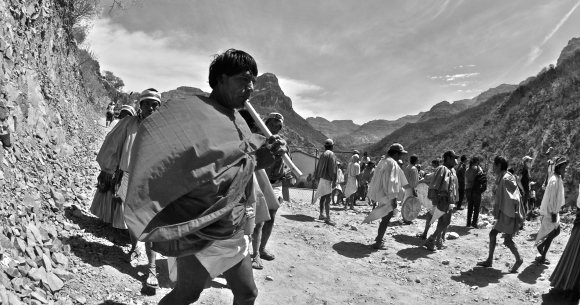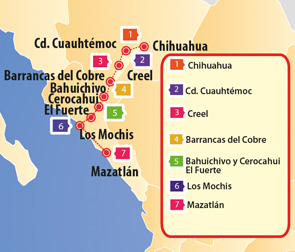Route 2
The Millenary Tarahumaras (Raramuri)
Chihuahua
This is a city of quarry stone and clear skies. It is not strange to run into Rarámuri people on the streets, who descend from the Tarahumara Mountains to do their shopping or offer their handcrafts. There are many treasures to be found in the city such as excellent cuts of beef, cold beer, friendly people and other amenities from northern Mexico. Exploring mansions from the times of the Mexican Revolution, the cathedral, and Pancho Villa’s old house and grave make this destination an interesting lesson in history. This is where the Chihuahua-Pacífico train route begins, which crosses the dramatic Barrancas del Cobre (Copper Canyon).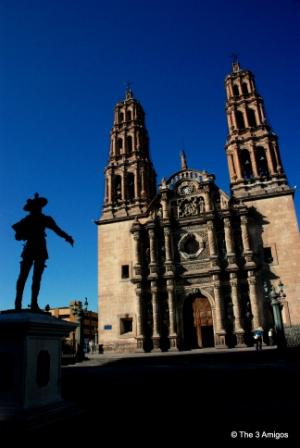
Chihuahua was the seat of the conquest of the Mexican Old West and its popular art reflect it faithfully in our time. Immemorial Tarahumara (Raramuri) handicrafts share spaces and shop windows with boots, leather, forged metal and filigree, inherited from the first cowboys in North America. For the skilled collector, it may be impossible to go without an original Texan hat, or else a piece made from woven palm made like when only the Rarámuri walked this land.
Strolling around Chihuahua one can imagine the heroic and often times terrible hours that were spent building Mexico. Inside the ancient Palacio Federal – which is today called Casa Chihuahua – the voice of the father of the nation, Don Miguel Hidalgo, resounds. Miguel Hidalgo was murdered in this capital city during the Independence and one can see what he scribbled on the wall of his dungeon cell. A few blocks ahead, the intense sun draws a revolutionary silhouette at Casa de Villa where an old Dodge car is exhibited with bullet holes: nine of them reached the revolutionary leader Pancho Villa, three ended his life; none of them would erase his legend.
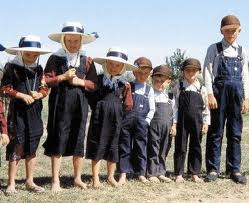 Cuauhtemoc
Cuauhtemoc
Demographically speaking, the municipality of Cuauhtémoc is an exciting case of coincidence, coexistence and adaptation. Here, where the Sierra Madre can begin to be seen, are two exceptional communities of varying culture; Menonitas and Rarámuris who daily show a way of life based on extremes. On the one side: the original Native Americans, with their ancestral customs and their infinite memory; on the other: the ultimate European immigrants, always searching for their definitive place on earth. The backdrop is the Sierra, with its valleys and mountains, and the clash of culture is evident everywhere you look.
When the Chepe train arrives at Ciudad Cuauhtémoc from Chihuahua, one feels that a decision is to be made. Following the train route would take one high up into the Sierra peaks to later plunge into the surreal ravines, in a race towards the sea. Getting off the train at this station would lead one on the “apple route” to the heart of one of the most driving agro-industrial zones in the country; the very heart of the Menonite community in Mexico. Although it seems impossible, the right answer is to go in both directions.
Creel
This logging town is considered the entrance to the vast Tarahumara Mountains. Groups of travelers interested in extreme sports tend to start their journeys here. There are those who would rather enjoy the tranquility of its two churches, or of Arareko Lake, the Valleys of the Mushroooms, Frogs and Monks, the Cusárare waterfall, the Jesuit missions, or Loyola Museum with its magnificent collection of Colonial art. It is a great place to feel proud of being Mexican or to feel privileged to visit in Mexico.
Creel was established as a necessary stopping point for the titanic enterprise that was laying out the tracks for the Kansas City, Mexico and East train, known today as the Chihuahua-Pacific. Its name comes from the state governor at the time, Enrique Creel Cuilty, and although at first it was a lumber-producing settlement, today it is associated with the exceptional landscapes and thrives on tourism. Cute shops and restaurants line the main street and artists abound in this sleepy little alpine town.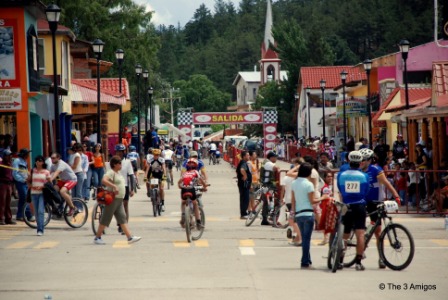
The millenary magic of the Raramuri people is unquestionably presented to the traveler who arrives in Creel. This settlement was responsible, in a way, for safeguarding their culture in our memories when it became the railroad hub that would bring civilization closer to this wild and extremely beautiful landscape where they live. Walking around the town immediately brings one closer to individuals from this ethnic group. In its surroundings, among deep forests and magnificent rocky columns, the Rararamuri live in caves and houses that reflect the way of life of their ancestors.
A pottery vase or wood carving at any of the local shops, or better yet, direct from a Raramuri, can serve as a beginning to understand where the incomparable originality of Tarahumara people comes from. In their basketry, their toys and dolls, in their drums and other musical instruments, that which is of everyday use becomes unique. These are, truly, handcrafts: expressions of a living culture, art derived from the most essential of resources; and they can be acquired at stores or from the hands of their artisan creators on the streets, any one of which would be worthy of being in a museum.
There are bike rentals, ATV rentals, scooter rentals and even truck rentals available in Creel as well as horseback riding, English speaking guides and boats for hire on the lake. Ask anyone from The 3 Amigos offices for suggestions on how to spend your time and you’ll be given many options based on your personal activity levels and interests.
The train, the forest, the vertiginous canyons all present a constant and enigmatic direct view to the ethnic origin of the world. A certain kind of magic lives in Creel to the degree that in 2007 it was named a Magic Town, a special certification in Mexico that elevates the status of a town to something special that one should not miss; a ‘guardian’ if you will of a culture and its millenary traditions that opens its arms wide to bring you the Copper Canyon in all its glory.
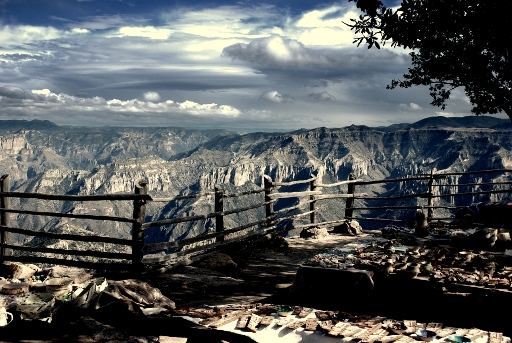 Copper Canyon
Copper Canyon
The group of canyons in the Sierra Madre is more extensive and deep than the Grand Canyon; it is an impressive site, not only because of the incredible landscape, but also because of the ethnic richness of the locals. However you must get off the trainline to feel the sheer magnitude of the spectacular Copper Canyon. These are the steep canyons of the “light-footed” people: the Rarámuri.
Someone is running down a steep ravine, and then another, and another; he runs for hours, maybe for days. In front of him, a small ball made with roots which he kicks with every step. This is a game, a competition, and a way of life: the Tarahumara people are the Ferrari’s of the canyon, they were born to run. In their universe they coexist with the Christian God and also with the shaman, the cult of peyote and communitarian democracy. They run barefoot at night, on dirt paths right next to ravines.
The only way to see the sights of the Cusarare or Basaseachi Waterfalls, the lake, the valley’s area with the strange rock formations or the hot springs is to explore out from Creel. The Copper Canyon represents a paradise for lovers of nature, flora, fauna and adventure sports.
Imagine a train running through Colorado’s Grand Canyon. If you multiply that by three, in size, you could get an idea of what the railroad track from Chihuahua to the Pacific is like. The sheer size of this rail road line enterprise is overwhelming even today; add to the image 37 bridges and 84 tunnels, impossible precipices and ravines, and a descent of 700 km from the highlands to the sea. A tribute to the human effort, El Chepe is proof that there are no bigger obsessions than those of railroad engineers.
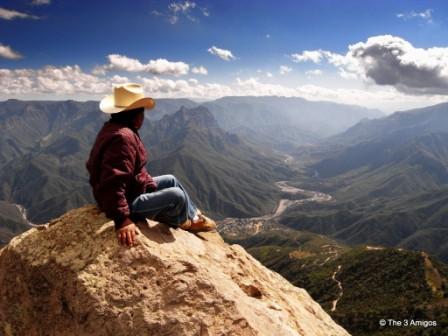 Bahuichivo/Cerocahui
Bahuichivo/Cerocahui
If you travel on the Chepe train, you must get off at the Bahuichivo station to reach Cerocahui, a little town surrounded by waterfalls and beautiful valleys. At a distance of 45 minutes on a dirt road you can find Cerocahui and from there, a great repertoire of possible routes to explore natural waterfalls, spectacular viewpoints – like the one that overlooks the Urique Canyon from Gallegos Mountain – and pastoral fruit-tree valleys.
Cerocahui is the starting point for exploring Urique Canyon, nearly two thousand meters deep. You should visit the San Javier mission, the Cerocahui Waterfall, and the boarding school for Rarámuri girls. Twenty five kilometers away is Del Gallego Mountain, where the viewpoint called Cerro de Gallego offers a spectacular viewpoint of Urique Canyon and the village below.
There are few hotels in Cerocahui but all include meals and transfers to and from the train station for their guests so that one can spend one’s time admiring the landscape and relaxing as one should on vacation.
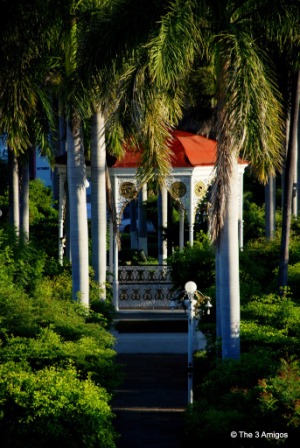 El Fuerte
El Fuerte
Another one of the acclaimed destinations on the Chepe route, this is a Colonial town that served as an important mining center during the 19th Century. It is worth discovering its large mansions, currently turned into gorgeous hotels. The central plaza and its cathedral present a beautiful image, along with lush vegetation. A guided kayak tour or river tour along the El Fuerte River is ideal and one can listen to the folktales and stories about El Zorro that abound. Legend is that Zorro was originally from this town but it has never been officially proven of course.
El Fuerte was once the capital of the Estado Libre de Occidente, which was the joined states of Sinaloa, Sonora and part of Arizona; El Fuerte is undoubtedly the most luxurious station of the very famous El Chepe. The tracks reached this settlement from Los Mochis in 1928, but it took 33 more years to finish the 260 km that separate it from Creel, for it is precisely this stretch that presented the most technical challenges. There is more than two kilometers between the altitude of this town and the highest point of the route, at 2,450 meters above sea level.
Former mining settlement, scenario of important political and military events, of incredible architectural wealth and long history, El Fuerte was admitted as a Pueblo Mágico in 2009. It shouldn’t surprise us, for it is also a contact point with the Mayo-Yoreme culture, which has fascinating customs and traditions. Add to this a very broad gastronomic offer, a Colonial fortification that gives it its name, and a collection of ancient haciendas turned into picturesque hotels, and we have a destination that is unique in its own right.
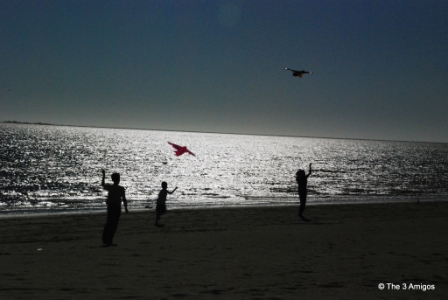 Los Mochis
Los Mochis
Los Mochis, Sinaloa, is the final or initial destination for the Chihuahua-Pacific train. This destination, of agricultural and industrial tradition, is famous for its seafood. A visit to El Maviri Beach near the Bay is worth it, as well as taking a yacht trip to observe dolphin families. Ships to La Paz, Baja California, sail from the port of Topolobampo. From the port, you can link this route with another, via ferry, which crosses the Sea of Cortés and lands in Baja California.
To book a trip through the Route 2 Region, please send us an email to; info@weareonetravel.com or fill in the Contact Form on the right hand side of this page.
